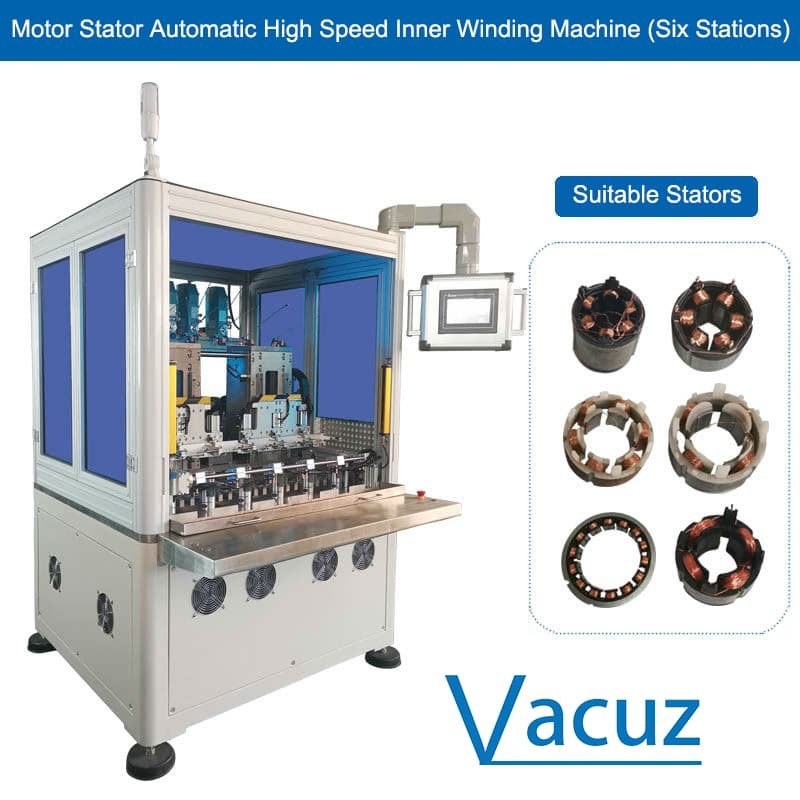There are many different types of automatic winding machines for brushless motors. Different stator products require different winding equipment. So, what are the stator requirements for automatic winding machines for brushless motors? How do you choose winding equipment based on your stator? Vacuz will briefly explain this below! We hope it helps!

I. Key Requirements for Automatic Winding Machines for Brushless Motors
1. Matching the Slot Orientation with the Winding Method
Outward-facing Slots: A flying fork external winding machine is preferred. It offers low cost and high efficiency, and is suitable for brushless motors or stators with outward-facing slots.
Inward-facing Slots: A needle internal winding machine is required, offering higher wire routing accuracy and suitable for stators with inward-facing slots, such as brushless motors.
2. Dimensional Compatibility
Outer and Inner Diameters:
Small stators (10-70mm): A multi-station machine (such as a four-station machine) is recommended.
Large stators (>120mm): A single-station machine is required to ensure sufficient winding space.
Height: Wires exceeding 70mm require custom equipment to avoid excessive swing and wire breakage.
Stacking thickness: Wires exceeding 150mm require custom equipment, which is difficult for standard equipment to meet.
3. Wire Diameter and Winding Speed
Thin wire (<0.1mm): Precision tension control is required, and the speed can be increased appropriately.
Thick wire (>0.8mm): The speed should be reduced and the tension increased to ensure coil tightness.
Multiple-wire winding: Synchronous winding capabilities and a complex wire routing system are required to prevent entanglement.
4. Slot Distance and Wire Routing Accuracy
Small slot distances require high-precision equipment (error ≤ ±0.01mm) to avoid scratching the wire.
5. Number of Turns and Speed Requirements
High number of turns: Select a high-speed winding machine (such as a multi-station external winding machine) to improve efficiency.
Fewer turns but high accuracy: Select precision single-station equipment.
II. Equipment Selection Steps
Determine the slot orientation: External winding machine (slots facing outward) or Internal winding machine (slots facing inward).
Matching size and workstations:
Small stators: Multi-station equipment (four/six stations).
Large stators or special heights: Single-station or custom equipment.
Wire diameter and configuration:
Single-wire winding: Standard winding machine.
Multi-wire parallel winding: High-precision equipment (with synchronization function).
Evaluate speed requirements: High-speed multi-station (efficiency first) or precision single-station (accuracy first).
Verify compatibility:
Mold versatility: Supports quick changeover.
Parameter flexibility: Presets can be made via PLC/touch screen.
Customization capabilities: Accommodates special slots or extra-thick stacks.
III. Key indicators for manufacturer selection:
Technical strength: Custom design capabilities. High-precision transmission components (servo motors, precision guides). Equipment Stability: Dynamic response optimization system controls acceleration rate.
After-sales Service: 24-hour response, 48-hour on-site repair.
Regular maintenance (cleaning and lubrication of key components) is provided.
Industry Reputation: Excellent reputation and a strong manufacturer.

What are the stator requirements for brushless motor automatic winding machines? How should winding equipment be selected based on the stator? Vacuz has provided a brief explanation above. We hope this information is helpful!
電子メール:sales@vacuz.com [fusion_form form_post_id="431″ margin_top="" margin_right="" margin_bottom="" margin_left="" hide_on_mobile="small-visibility,medium-visibility,large-visibility" class="" id=""][/fusion_form].

